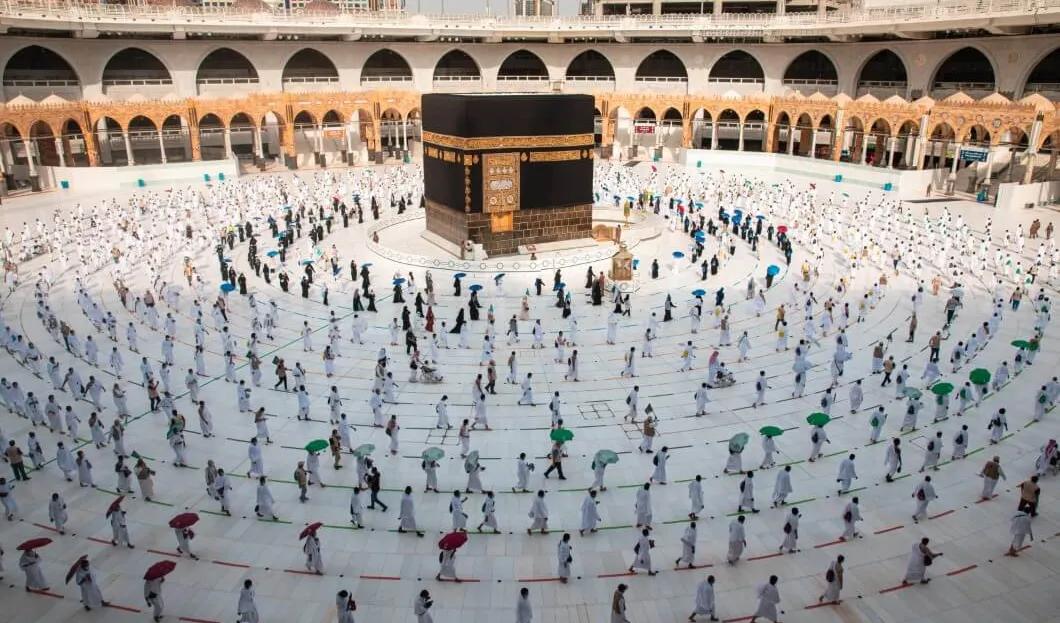
The Hajj, the largest pilgrimage in the Muslim world, has begun in Mecca, Saudi Arabia. But this year again, only a few tens of thousands of pilgrims are allowed to participate because of the pandemic. A definite loss of income for the first economy of the Gulf and an opportunity for religious tourism hard hit by the pandemic around the world.
For the second year in a row, the Saudi authorities have drastically reduced the number of Muslims taking part in the Hajj, which was held from 17 to 22 July 2021: barely 60,000 pilgrims, all residents of Saudi Arabia, aged between 18 and 65, suffering from no chronic illness and, above all, properly vaccinated. This is a far cry from the two and a half million pilgrims who flocked the holy city of Mecca in 2019 coming from all over the world.
The loss of revenue for the Saudi economy is considerable. Before the pandemic, the hajj brought in an average of 10 to 15 billion dollars a year to the kingdom, in addition to the 4 to 5 billion spent by the eight million or so pilgrims during the omra - the small, non-compulsory pilgrimage that can be made throughout the year. The lost windfall of religious tourism is equivalent to 7% of Saudi GDP. It is the second-largest contribution to the country's economy, just behind oil.
It is a disaster for Saudi finances but not the only. Elsewhere in the world, especially in Africa, tens of thousands of travel agencies specializing in religious tourism have found themselves out of business overnight.
Global Crisis for Religious Tourism
This situation does not only affect Saudi Arabia. Most of the major religious gatherings have been cancelled, with the notable exception of the Kumbh Mela, the great Hindu pilgrimage that brought together up to 9 million pilgrims on the banks of the Ganges last April and over several weeks. But India is still paying a high price, with more than 411,000 deaths to date due to the spread of the Delta variant, which now accounts for the majority of new infections worldwide.
In Europe, for example, destinations such as Lourdes in France, Santiago de Compostela in Spain and Fatima in Portugal recorded a drop in activity of 75% on average last year.
With the drastic reduction in the number of pilgrims in these major pilgrimage sites, the entire local economy, starting with the hotel and restaurant industry, has been seriously affected.
With the cancellation of the great pilgrimage, Lourdes, the second-largest hotel city in France after Paris, recorded an occupancy rate of barely 25% of its establishments last year. Some 2,500 seasonal workers in these sectors were left jobless. The number of shops, especially souvenir shops, that have closed down is countless. This year again, the scenario is likely to be repeated, forcing the pilgrims to follow the celebrations on screens.
Non-believers to the Rescue of Religious Tourism
Perhaps the salvation for some of these sites could come from non-believers. The pandemic has profoundly altered people’s relationship to tourism. The restrictive measures put in place to curb the spread of the virus have put a stop to travelling abroad. The successive confinements have created a desire for nature, for wide-open spaces. And the need to find oneself, to find the meaning of one's life – it has never been so present.

In this context, pilgrimages could well become the new trend in post-Covid-19 travel. This is the case for the roads to Santiago de Compostela, which are welcoming more and more travelers and not only pilgrims. According to a study relayed by the National Geographic magazine, 40% of the walkers who take these paths in France, Spain and Portugal are now non-believers.
Elsewhere in Europe, in Ireland, Wales, Finland and Sweden, there is the same craze for this type of travel, made up of walks in the open air and visits to religious sites. These new kinds of pilgrims stay, consume and participate in the economy of the territories they cross. In short, they are a breath of fresh air for religious tourism in crisis.









